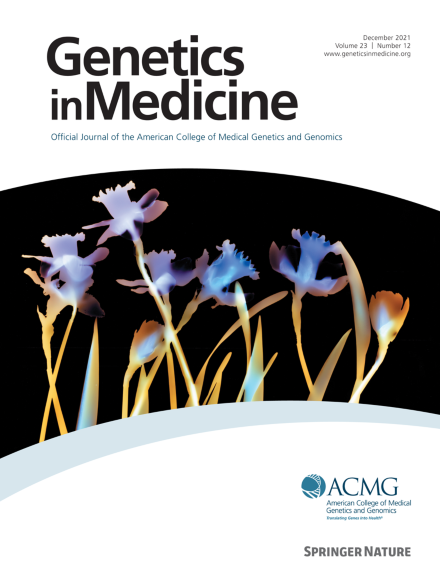Venous thromboembolism laboratory testing (factor V Leiden and factor II c.∗97G>A), 2025 revision: A technical standard of the American College of Medical Genetics and Genomics (ACMG)
IF 6.2
1区 医学
Q1 GENETICS & HEREDITY
引用次数: 0
Abstract
Venous thromboembolism (VTE) occurs when a blood clot forms in a vein. The etiology of VTE is multifactorial, including both environmental and genetic factors. Among the genetic factors, factor V Leiden and factor II c.∗97G>A (formerly referred to as prothrombin 20210G>A) are the 2 most common genetic variants associated with VTE. Testing for these variants is one of the most common referrals in clinical genetics laboratories. Although the methodologies for testing these 2 variants are relatively straightforward, the clinical implementation can be complicated regarding test indications, risk assessment for occurrence, and recurrence of VTE and related genetic counseling. This document provides an overview of VTE, information about the variants and their influence on risk, considerations before initiating genetic testing, and the clinical and analytical sensitivity and specificity of the tests. Key information that should be included in the laboratory report is also provided. This document supersedes the Technical Standards and Guidelines for Venous Thromboembolism Laboratory Testing originally published in 2005 and revised in 2018. It is designed for genetic testing professionals familiar with the disease and the analysis methods.
静脉血栓栓塞实验室检测(因子V Leiden和因子II c. * 97G>A), 2025修订版:美国医学遗传学和基因组学学院技术标准(ACMG)
静脉血栓栓塞(VTE)发生时,血液凝块在静脉形成。静脉血栓栓塞的病因是多因素的,包括环境和遗传因素。在遗传因素中,因子V Leiden和因子II c * 97G>;A(以前称为凝血酶原20210G>;A)是与VTE相关的两种最常见的遗传变异。检测这些变异是临床遗传学实验室最常见的转诊之一。尽管检测这两种变异的方法相对简单,但临床实施在检测适应症、发生风险评估、静脉血栓栓塞复发和相关遗传咨询方面可能会很复杂。本文档概述了静脉血栓栓塞,有关变异及其对风险的影响的信息,开始基因检测前的注意事项,以及测试的临床和分析敏感性和特异性。还提供了应包括在实验室报告中的关键信息。本文件取代了最初于2005年发布并于2018年修订的《静脉血栓栓塞实验室检测技术标准和指南》。它是为熟悉疾病和分析方法的基因检测专业人员设计的。
本文章由计算机程序翻译,如有差异,请以英文原文为准。
求助全文
约1分钟内获得全文
求助全文
来源期刊

Genetics in Medicine
医学-遗传学
CiteScore
15.20
自引率
6.80%
发文量
857
审稿时长
1.3 weeks
期刊介绍:
Genetics in Medicine (GIM) is the official journal of the American College of Medical Genetics and Genomics. The journal''s mission is to enhance the knowledge, understanding, and practice of medical genetics and genomics through publications in clinical and laboratory genetics and genomics, including ethical, legal, and social issues as well as public health.
GIM encourages research that combats racism, includes diverse populations and is written by authors from diverse and underrepresented backgrounds.
 求助内容:
求助内容: 应助结果提醒方式:
应助结果提醒方式:


